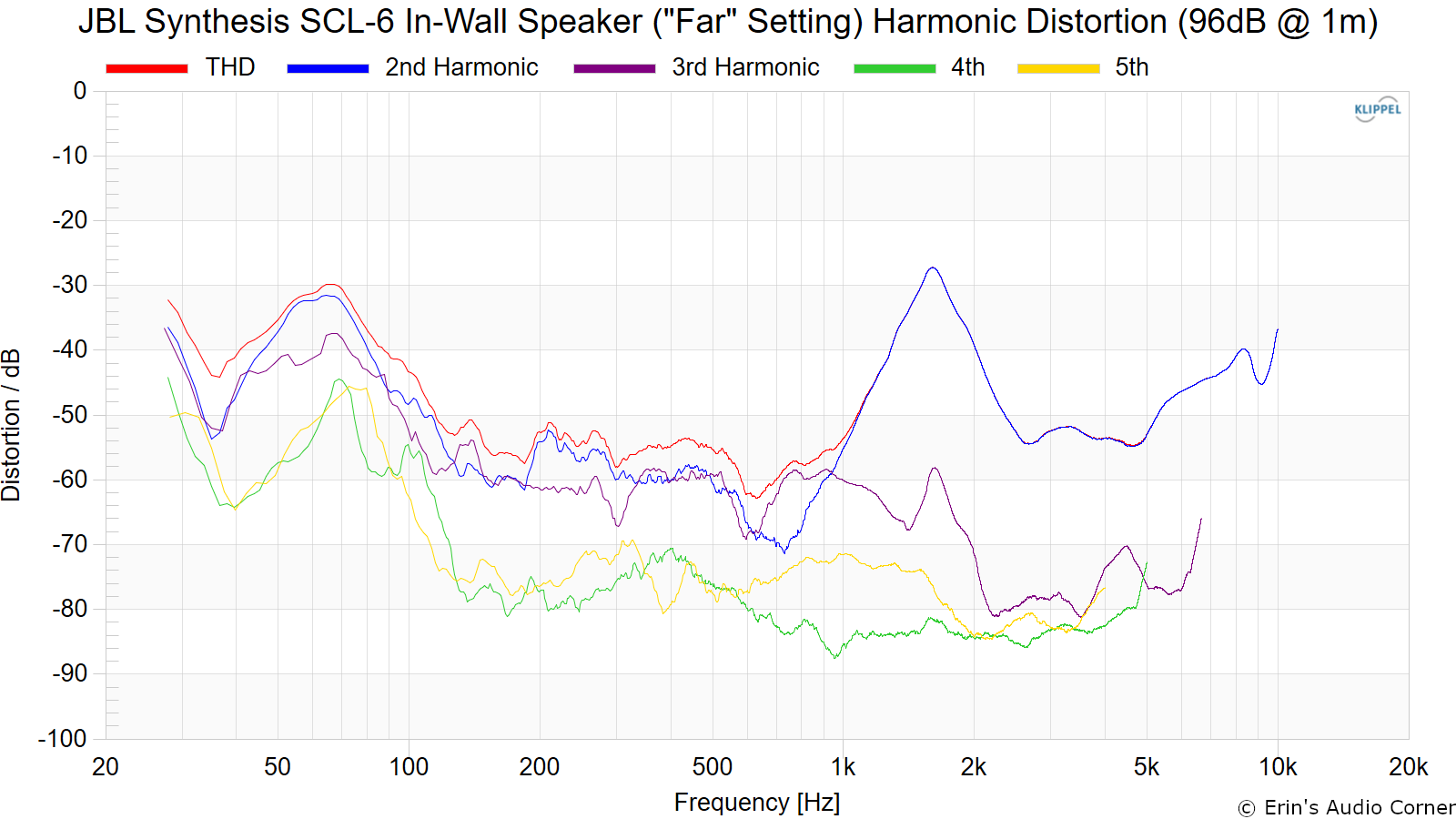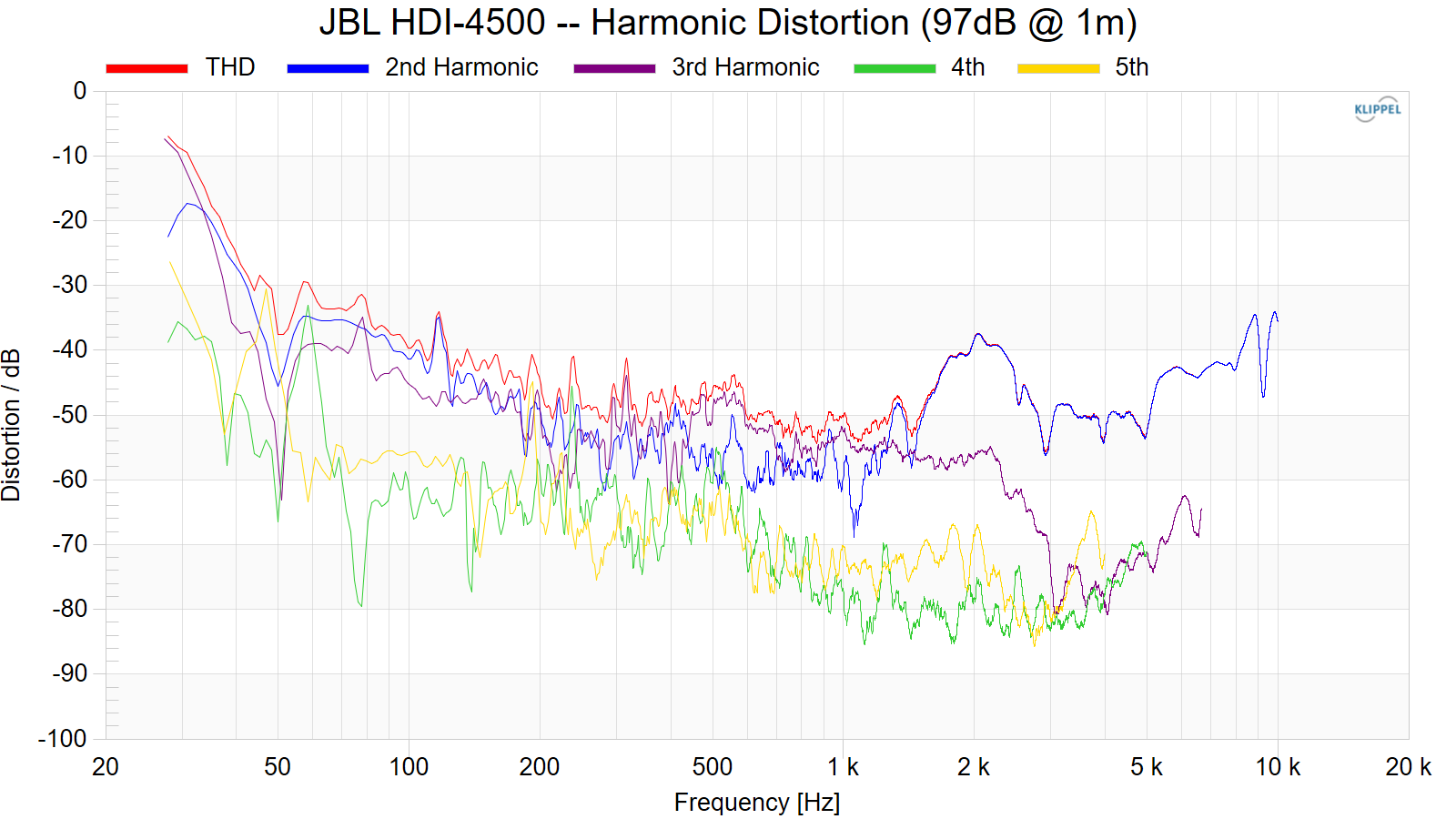Yes I was surprised by the "news is not that bad overall" If it's not bad wonder how bad looks like.Well, with 10% distortion between 1kHz and 2kHz, that's just "broken", isn't it ?
And, on top of this, the assymetrical layout doesn't solve the vertical directivity issue typical of MTM design, but adds its own.
Hmm...
-
WANTED: Happy members who like to discuss audio and other topics related to our interest. Desire to learn and share knowledge of science required. There are many reviews of audio hardware and expert members to help answer your questions. Click here to have your audio equipment measured for free!
You are using an out of date browser. It may not display this or other websites correctly.
You should upgrade or use an alternative browser.
You should upgrade or use an alternative browser.
JBL SCL-7 Review (In-wall Speaker)
- Thread starter amirm
- Start date
@amirm I don't think it is correct to analyse a speaker which is designed not to have a symmetrical polar pattern as if it was. None of the bounce calculations means much here. This is a specialised speaker designed to be mounted horisontal or vertical but always listened off-centre. Shouldn't it be tested for the job it is advertised as?
According to JBL:
According to JBL:
The innovative configuration yields incredibly smooth and consistent performance for off-axis placement up to 45 degrees from the listening position.
User manualSCL-7 | 2-Way Dual 5.25-inch (130mm) In-Wall Loudspeaker
The SCL-7 is the smallest traditional in-wall model in the JBL Synthesis Custom Loudspeaker (SCL) series. It is designed for use as a width or surround channel or as an LCR in smaller systems. The SCL-7 features JBL’s patented 2410H-2 1-inch (25mm) compression driver mated to an offset High...www.jblsynthesis.com
Trouble Maker
Addicted to Fun and Learning
It's early to tell a trend, but my recollection is that so far the more expensive in walls haven't measured super well but we've had some relatively inexpensive ones do pretty well. I've wanted to do a (mostly) in-wall system for a while and I'm glad my procrastination allowed me to see more measurements of in-walls. If I had the money (I don't) I think before seeing Amirm & Erin's measurements the JBL Synthesis line would have been an 'easy' choice given the general reputation of JBL's pro and 'higher end' speakers.
When the issues of MTM get's thrown in, which should push towards 3 ways, the field also really narrows for an in wall center.
When the issues of MTM get's thrown in, which should push towards 3 ways, the field also really narrows for an in wall center.
Interesting, @amirm if this is the recommended application, did you get a chance to place the measurement microphone vertically offset at 30 degrees? But then given that the vertical dispersion is quite narrow, I don't know if things will improve@amirm I don't think it is correct to analyse a speaker which is designed not to have a symmetrical polar pattern as if it was. None of the bounce calculations means much here. This is a specialised speaker designed to be mounted horisontal or vertical but always listened off-centre. Shouldn't it be tested for the job it is advertised as?
According to JBL:
@amirm I don't think it is correct to analyse a speaker which is designed not to have a symmetrical polar pattern as if it was. None of the bounce calculations means much here. This is a specialised speaker designed to be mounted horisontal or vertical but always listened off-centre. Shouldn't it be tested for the job it is advertised as?
According to JBL:
Using the Klippel you can always generate the impulse response at any angle you want. So @amirm could (i have no idea how easy it is i just know it's possible) generate the spinorama at whichever degree he wants without having to measure it again.
But honestly i doubt the story would be any different, we already have a full 360 degrees (well 180 in this case) polar map of the speaker.
But looking at the early reflections breakout the rear-wall reflections (which in reality doesn't really exist) is indeed pushing that null even further down.
If the on-axis is at 30 degrees wouldn’t the ceiling, floor, walls reading will change, hence the in-room chart be different? Also, wouldn’t the horizontal and vertical orientation alter the charts as well? What were treated as side-walls will be floor & ceiling.But honestly i doubt the story would be any different, we already have a full 360 degrees (well 180 in this case) polar map of the speaker.
But looking at the early reflections breakout the rear-wall calculation (which in reality doesn't really exist) is indeed pushing that null even further down.
This is a specialised speaker. I don’t think it is fair to treat it as just another speaker. Other than saying it use an “asymmetrical horn” there are no measurements to quantify what is that asymmetry is about.
Maybe? -15 degrees vertically won't completely change the entire narrative (Honestly looking at the polar plots it might make it even worse).If the on-axis is at 30 degrees wouldn’t the ceiling, floor, walls reading will change, hence the in-room chart be different? Also, wouldn’t the horizontal and vertical orientation alter the charts as well? What were treated as side-walls will be floor & ceiling.
But since the manufacturer specifies -15 degrees off-axis vertically (for some reason) as the acoustic axis it's worth the effort.
At 15 degrees below the speaker the vertical response isn't much different, no clue how the corresponding horizontal measurements would perform.
As for a non-symmetrical design, you are going to have 2 of these, one on each side, so the data is thus the average you'd get from both speakers. If you really wanted to have the different axes for use in seeing where to place absorbers, that's valid, but it doesn't matter in regards to seeing the Spinorama.
As for a non-symmetrical design, you are going to have 2 of these, one on each side, so the data is thus the average you'd get from both speakers. If you really wanted to have the different axes for use in seeing where to place absorbers, that's valid, but it doesn't matter in regards to seeing the Spinorama.
Maybe? -15 degrees vertically won't completely change the entire narrative (Honestly looking at the polar plots it might make it even worse).
Following is what JBL says. Why do you say 15 degrees?
| High Frequency Coverage Angle (-6 dB) |
|---|
| 60° Vertical, 90° Horizontal (Left 30°, Right 60°, from center line), from 2 kHz to 15 kHz |
This post? https://www.audiosciencereview.com/...l-7-review-in-wall-speaker.32602/post-1144154Following is what JBL says. Why do you say 15 degrees?
High Frequency Coverage Angle (-6 dB) 60° Vertical, 90° Horizontal (Left 30°, Right 60°, from center line), from 2 kHz to 15 kHz
This is a weird one for sure. I wish they made a version of this without the offset. That distortion measurement is disappointing. I wonder if there is something wrong with this sample. I hope Amir can get a response from someone at JBL.
Understood. I need a geometry refresher
You call it weird, JBL calls is specialised. Otherwise they have "normal" models, SCL-2 and SCL-6.This is a weird one for sure. I wish they made a version of this without the offset. That distortion measurement is disappointing. I wonder if there is something wrong with this sample. I hope Amir can get a response from someone at JBL.
nathan
Senior Member
- Joined
- May 24, 2020
- Messages
- 365
- Likes
- 255
Hmmm. Does this show a dip at 2k on the JBL official measurements.....but that it then recovers less than in Amirm's measurements as one goes higher in the frequency range?


....and why wouldn't I go with something like the Revel, instead, like below, given what we see from the synthesis speaker? (Other than the cool angled dispersion pattern of the JBL which I like "in concept" for left, right, and perhaps front wide and rear surround uses.)


....and why wouldn't I go with something like the Revel, instead, like below, given what we see from the synthesis speaker? (Other than the cool angled dispersion pattern of the JBL which I like "in concept" for left, right, and perhaps front wide and rear surround uses.)
nick-v
Active Member
- Joined
- Sep 14, 2018
- Messages
- 195
- Likes
- 289
There is a similar distortion peak on the SCL-6 review from Erin's Audio Corner.That distortion peak looks like a tweeter buzzing. It can happen due to a misaligned voice coil or loose components. Feed it a 2k signal and listen for a buzz or rattle. otoh it is on both sides, so very weird.

It's a little odd though, because it's the same tweeter (and woofers) as the HDI-4500 which doesn't show quite the same distortion peak:

Must be the tweeter though, because it shows up on the HDI-1600 (same tweeter) review as well:
Last edited:
SubsonicLurker
Member
Similar threads
- Poll
- Replies
- 65
- Views
- 13K
- Poll
- Replies
- 225
- Views
- 23K
- Poll
- Replies
- 237
- Views
- 40K
D
- Replies
- 149
- Views
- 29K
- Replies
- 61
- Views
- 17K
